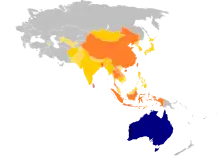| Total population | |
|---|---|
| 138,463 (2021, by ancestry) 122,506 (2021, by country of birth)[1] | |
| Regions with significant populations | |
| Sydney · Melbourne | |
| Languages | |
| English · Nepali | |
| Religion | |
| Majority Hinduism · Buddhism · Kirant Mundhum · Christian minorities. | |
| Related ethnic groups | |
| Non Resident Nepali |
Nepalese Australians are the citizens and residents in Australia whose ethnic origins lie fully or partially in Nepal. Nepalese started to settle in Australia from the 1960s,[2] but the vast majority of Nepalese Australians arrived after 2006.[3]
Australian residents of Nepalese origin have significantly increased in recent years: in the 2021 census, 138,463 people reported Nepalese ancestry, 0.54% of the total population. Just five years before, in the 2016 census, there were only 62,806 people with Nepalese ancestry. This follows after the population of this community quardrupled in the 5 years to 2011, and doubled again in the 5 years in 2016.[4][3]
Lhotshampa refugees
About 5,000 Lhotshampas or Bhutanese refugees who are living in various refugee camps of Nepal are being resettled in Australia. They share common language and culture with the mainstream Nepali.[5]
Since 1990, ethnic Nepalis in more than 110,000 in numbers, who were forced out of Bhutan have temporarily settled in refugee camps in eastern part of Nepal. After the 15 years of exile they are now being resettled in Australia, US and Europe. By the end of the resettlement program it is estimated that around 5,000 of Bhutanese will be in Australia.[6]
International students
The number of Nepalese students seeking admission to universities in Australia is increasing. The instability caused by the Maoist insurgency and Gorkha earthquake of 2015, has led Nepalese students to turn to Australia for academic pursuits. The figures from the federal Government’s Australian Education International (AEI) in 2007 show that in the 12 months to September, commencements by students from Nepal increased by 504 per cent, or 2884 students.[7] According to data provided by the Australian Home Affairs, the period spanning from 2018 to 2019 saw the issuance of 31,799 student visas, which decreased to 24,445 from 2019 to 2020, further declining to 20,585 from 2020 to 2021, and subsequently increased to 30,667 from 2021 to 2022. As reported by the Australian Department of Education, the current year, 2023, witnesses an enrollment of over 53,170 Nepalese students pursuing their education in Australia. This numerical influx situates Nepal as the third most substantial origin of international students, trailing behind China and India.
Notable Nepalese Australians
- Dichen Lachman, actress
- Payal Shakya, former Miss Nepal
- Sarun Tamrakar, Nepali Singer
- Sanu Sharma, writer
- Shesh Ghale, businessman
- Jamuna Gurung,
- Nick Shrestha
See also
References
- ↑ ABS - Census 2021 - Cultural Diversity Summary
- ↑ "Travelling castes: Nepalese immigrants in Australia".
- 1 2 Department of Home Affairs, Nepal-born Community Information Summary
- ↑ ABS Census data 2016 and 2021, via .id Community https://profile.id.com.au/australia/ancestry?EndYear=2016&DataType=UR
- ↑ Bhutanese resettlement
- ↑ Bhutanese refugee
- ↑ The Australian - Huge increase in Nepalese students
External links
- ↑ According to the local classification, South Caucasian peoples (Azerbaijanis, Armenians, Georgians) belong not to the European but to the "Central Asian" group, despite the fact that the territory of Transcaucasia has nothing to do with Central Asia and geographically belongs mostly to Western Asia.
